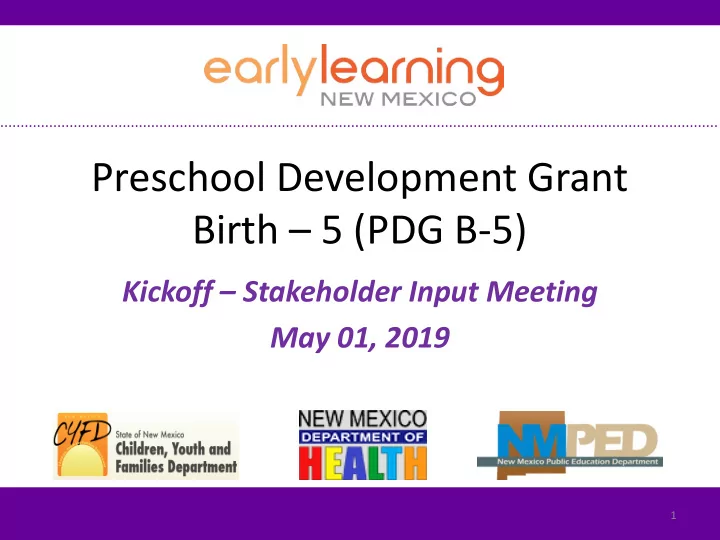

Preschool Development Grant Birth – 5 (PDG B-5) Kickoff – Stakeholder Input Meeting May 01, 2019 1
Meeting goals for today: • To share the overview, vision and process of the PDG B-5; • To collect input that will help inform NM’s early learning Needs Assessment and Strategic Plan activities of the PDG B-5; • Explore ongoing ways that stakeholders can be involved in the success of New Mexico’s early learning Needs Assessment and Strategic Plan. 2
Time Topic 10:00 – 10:30 Welcome and Introductions 10:30 – 11:30 Kick-Off of PDG B-5 – Overview and Vision 11:30 – 11:40 Transition to Small Groups 11:40 – 12:30 Small Group Discussion to Gather Input on: Communities Partners & Approaches for Engaging Vulnerable Populations Survey 12:30 – 1:00 Working Lunch in Small Groups 1:00 – 1:30 Finish Small Group Discussion & Prepare for Report-Out 1:30 – 2:15 Report-Out from Small Group Discussions 2:15 – 2:30 Stakeholder Involvement Moving Forward 3 2:30 – 3:00 Wrap-Up
4
NM’s PDG B-5 Vision: Each and every child, prenatal to age five, and their families in New Mexico will have equitable access to quality early learning opportunities to support their development, health and well- being ensuring they are ready to succeed in kindergarten and beyond. Goals 1. Collaboration and Coordination . Early learning stakeholders partner at all levels to achieve a coordinated, aligned, efficient, & accountable statewide early learning system 2. Equitable Access . Parents have knowledge and access to community resources and comprehensive early learning services 3. Quality . Children are ready to succeed in kindergarten and beyond 5
Background ( stars are aligning ) • $37.5 Million Race To Top – Early Childhood Challenge Grant (Jan 2013 - Dec 2017) • Shared governance under Early Learning New Mexico www.earlylearningnm.org between CYFD, PED and DOH • Awarded $5.4 Million Preschool Development Grant Birth - 5 (final award 03/08/19) • SB22 signed in law by Governor Lujan Grisham on 03/14/19 creating the Early Childhood Education & Care Department 6
• ECIDS (Integrated Preschool Data System) Development Grant Birth -5 • Consolidated • ‘FOCUS’ TQRIS Governance • Investment Zones • Needs Assessment • Alignment, • Kindergarten • Strategic plan efficiencies & Observation Tool • Early learning building quality • Professional media campaign across programs development • Professional Early Childhood Race To the Top – Development Education and Care Early Learning • Enhancing quality Department Challenge 7
PDG B-5 Alignment and opportunities: • Early Childhood Education and Care Department – PDG B-5 Needs Assessment research and data will inform the transition planning for the ECECD – PDG B-5 3-Year Strategic Plan will provide a strategic direction for the ECECD 8
Alignment and Opportunities: • Pritzker Children’s Initiative $100K grant award – 9 month grant to develop an infant-toddler policy agenda – Will work with PDG B-5 team to ensure alignment and avoid duplication • Title V Maternal Child Health - Needs Assessment – Working collaboratively w/ Public Health – Family Health Bureau • Maternal Infant Early Childhood Home Visiting (MIECHV) Needs Assessment – due Oct. 2020 9
PDG B-5 Activity Areas: 1. Conduct a statewide early learning ‘ Needs Assessment’ 2. Develop a 3-year early learning ‘strategic plan’ 3. Maximizing Parent Knowledge & Choice - Develop a multimedia early learning campaign and expanded Resource and Referral system 4. Sharing Best Practices - Develop and provide a variety of professional development and video exemplars 5. Improving overall quality of early learning services 10
11
• Questions? 12
Small Group Discussion to gather input for the statewide early learning needs assessment: Communities for Forums / Community Conversations – Recommendations and partners Vulnerable & Underserved Populations – Engaging partners & identifying strategies Statewide Early Learning Survey – Input on topics and distribution 13
In order to achieve our vision of providing access to quality early learning services statewide, we much assess the needs of: Underserved populations: Vulnerable populations • : • Rural communities; • Low income/poverty; • Frontier Communities; • Teen Parents; • Native American children. • Dual Language Learners; • Child Welfare; • Homeless children / families; • Developmental Delays and Disabilities; • Children with Special Health Care Needs (CSHCN); • Infant & Early Childhood Mental Health; • NICU; • Immigrant Families; • Prenatal/Current Drug Use by Parents; 14 Grandparents Raising Children/Kinship
Small Groups: 1. Immigrant Families; Dual Language Learners 2. Homeless Children 3. Children with Developmental Delays and Disabilities; Children with Special Health Care Needs 4. Infant and Early Childhood Mental Health; Prenatal/Current Drug Use by Parents, NICU 5. Teen Parents; Grandparents Raising Grandkids 6. Native American Children 7. Child Welfare 8. Frontier and Rural 15
Geographies 1. In which communities in the state should we be holding community forums? 2. Who are the key partners within these communities? Vulnerable and Underserved Populations 1. Who are the key partners who serve the vulnerable or underserved population you are discussing? 2. Should this particular group of vulnerable or underserved children and families have dedicated or separate conversations or forums in order to best collect their perspective and needs? 3. What strategies do you recommend to reach this population? Can you recommend creative ways to engage this population that are culturally and linguistically appropriate? 4. Can you play a role in connecting with these groups and/or populations? 16
Survey 1. Are these the right categories of questions? Are there key questions within these categories that you think are critical to include? 2. We want to ensure equitable access to the survey. What strategies do you recommend for disseminating a statewide survey to maximize participation? For example, is a paper survey helpful, in addition to an online one? 3. How can you help distribute the survey? 17
Recommend
More recommend